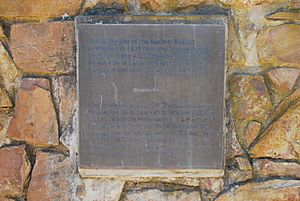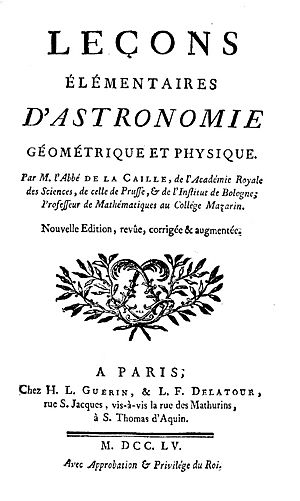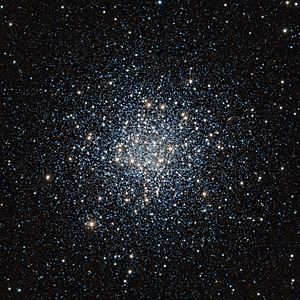Nicolas-Louis de Lacaille facts for kids
Quick facts for kids
Nicolas-Louis de Lacaille
|
|
|---|---|
 |
|
| Born | 15 March 1713 Rumigny, France
|
| Died | 21 March 1762 (aged 49) Paris, France
|
| Citizenship | French |
| Scientific career | |
| Fields | Astronomy |
Abbé Nicolas-Louis de Lacaille (15 March 1713 – 21 March 1762) was a French astronomer and geodesist. A geodesist is someone who measures the Earth's shape and size. He is famous for naming 14 of the 88 constellations we know today. From 1750 to 1754, he studied the sky at the Cape of Good Hope in what is now South Africa. Lacaille observed more than 10,000 stars using only a small telescope.
Contents
Early Life and Studies
Nicolas-Louis de Lacaille was born in Rumigny, a town in eastern France. He went to school in Mantes-sur-Seine. Later, he studied rhetoric and philosophy at the Collège de Lisieux. He then studied theology at the Collège de Navarre.
In 1731, his father passed away, leaving him without money. However, the Duc de Bourbon, who had supported his father, helped him continue his studies.
Becoming a Scientist
After finishing his studies, Lacaille decided not to become a priest. Instead, he focused on science. With the help of Jacques Cassini, another famous scientist, he got a job.
First, he helped survey the coast from Nantes to Bayonne. Then, in 1739, he worked on remeasuring the French meridian arc. This was a big project to accurately measure a line of longitude across France. He is honored with a pyramid at Juvisy-sur-Orge for this work.
This difficult job took two years. Lacaille's hard work and skill helped correct some old measurements. Because of his success, he became a member of the French Academy of Sciences. He also became a professor of mathematics at the Mazarin College in Paris. There, he built a small observatory for his own research.
Lacaille wrote many important textbooks. He strongly believed in Newton's ideas about gravity. Some of his students included Antoine Lavoisier and Jean Sylvain Bailly.
Journey to the Cape of Good Hope

Lacaille wanted to measure how far away the planets were. He planned to do this using a method called parallax. This method needs observations from very far apart places on Earth. So, in 1750, he suggested an expedition to the Cape of Good Hope in South Africa. The French government approved his trip.
At the Cape, he built an observatory near Table Bay. The Dutch Governor, Ryk Tulbagh, supported his work. For two years, Lacaille observed the southern sky almost every night. He recorded nearly 10,000 southern stars! He also noted 42 cloudy objects, which we now call nebulae.
He successfully measured the parallax of the Moon and the Sun. He used Mars to help with these measurements. Other astronomers in Europe, like Jérôme Lalande, made observations at the same time.
New Constellations
Lacaille's catalog of southern stars, called Coelum Australe Stelliferum, was published after he died in 1763. He created 14 new constellations that are still used today. One of these was Mons Mensae, which is the only constellation named after a place on Earth, Table Mountain.
Measuring the Earth's Shape
While at the Cape, Lacaille also measured a part of the Earth's curve. This was to find out the size and shape of the Earth in the southern half. He set up a starting line in the Swartland plain. Then, using a method called triangulation, he measured a 137-kilometer (85-mile) arc of a meridian. A meridian is an imaginary line that goes from the North Pole to the South Pole.
His measurements suggested that the Earth was flatter towards the South Pole than towards the North Pole. Later, in 1838, Thomas Maclear, another astronomer, repeated these measurements. He found that Lacaille's readings were slightly off because of the gravitational pull from nearby mountains, like Table Mountain.
Amazing Calculations
During his trip to the southern hemisphere, Lacaille realized how hard it was to find a ship's exact location at sea. When he returned to Paris, he created the first accurate tables of the Moon's position. These tables helped sailors figure out the time and their longitude using a method called 'Lunars'.
Lacaille was an amazing calculator. Besides creating tables for astronomy, he calculated a table of eclipses for 1800 years! Jérôme Lalande said that Lacaille made more observations and calculations in his short life than all other astronomers of his time combined. His work was not only a lot but also very good quality.
Later Life and Legacy
When Lacaille returned to Paris in 1754, he was surprised to find himself famous. He went back to work at the Mazarin College.
In 1757, he published Astronomiae Fundamenta Novissimus. This book listed about 400 bright stars with very accurate positions. He also calculated the paths of comets and was responsible for naming Halley's Comet.
His last public lecture was on September 14, 1761. He talked about all the improvements in astronomy during his lifetime, to which he had contributed a lot. Lacaille passed away in 1762, likely due to working too hard. He was buried in Paris.
Honours
Nicolas-Louis de Lacaille received many honors for his work:
- In 1754, he became a foreign member of the Royal Swedish Academy of Sciences.
- He was also an honorary member of academies in Saint Petersburg, Berlin, London (the Royal Society), Göttingen, and Bologna.
Lacaille has the honor of naming 14 different constellations:
- Antlia
- Caelum
- Circinus
- Fornax
- Horologium
- Mensa
- Microscopium
- Norma
- Octans
- Pictor
- Pyxis
- Reticulum
- Sculptor
- Telescopium
The crater "La Caille" on the Moon is named after him. An Asteroid called 9135 Lacaille was also named in his honor. A 60-cm telescope on Réunion Island will also be named the Lacaille Telescope to celebrate his contributions to studying the southern sky.
Main Works
Lacaille wrote many important books and papers, including:
- Leçons élémentaires de Mathématiques (1741) - A book about basic mathematics.
- Leçons élémentaires de Mécanique (1743) - A book about basic mechanics.
- Leçons élémentaires d'Astronomie (1746) - A book about basic astronomy.
- He published a catalog of 42 southern nebulae in 1755.
- Tabulae Solares (1758) - Tables related to the Sun.
- Coelum australe stelliferum (1763) - His famous catalog of southern stars, published after his death.
Images for kids
See also
 In Spanish: Nicolas-Louis de Lacaille para niños
In Spanish: Nicolas-Louis de Lacaille para niños




